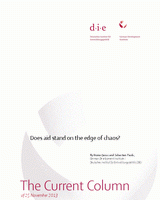Does aid stand on the edge of chaos?
Janus, Heiner/Sebastian PauloThe Current Column (2013)
Bonn: German Development Institute / Deutsches Institut für Entwicklungspolitik (DIE) (The Current Column of 25 November 2013)
Bonn, 25 November 2013. Aid is a polarising issue. Critics warn that development assistance does more harm than good, while proponents maintain that aid saves lives. In his book Aid on the Edge of Chaos (Oxford University Press, published 24 October 2013) Ben Ramalingam calls for a middle way. Modern development cooperation has fundamental deficiencies, but it can be reformed. While this issue has already been discussed extensively on a number of occasions, Aid on the Edge of Chaos sets a new milestone in the debate. What makes Ramalingam's ideas so innovative is not his criticism of the aid system, but rather the way he applies complexity theory, offering approaches for solving development problems more effectively.
Old criticism, new approaches
Ramalingam argues that many development problems are found on the edge of chaos, that is, between simple causal relationships and complete disorder. While aid is often too static and linear, it operates in a dynamic and complex environment. The author compares aid to a machine that produces standard recipes for clearly defined tasks. For every problem, there is a solution: vaccination campaigns combat diseases, fertilisers improve crop yield, and so on. The combined outcome of these activities results in aid being delivered as if on a conveyor belt. His criticism of the aid system sounds very familiar up to this point. International standards in development cooperation have long sought to avoid development measures simply being prescribed on a standardised basis. Also, it is already widely recognised that aid rarely provides an “external push” for development, but must rather act as a catalyst for change.
So why should Aid on the Edge of Chaos still become required reading for those interested in development? The book's real contribution is not found in its criticism of the aid system, but rather in the new approaches it puts forward to improve aid. Using complexity theory, Ramalingam provides analytical tools to help aid actors find their bearings on the edge of chaos. He takes the readers on an impressive interdisciplinary tour of theoretical approaches originally developed in the natural sciences. In this way, the author follows in the tradition of Elinor Ostrom, winner of the Nobel Prize for economics, who applied evolutionary theory to the field of social sciences. The book introduces many new and exotic terms, including power laws, fitness landscapes, network analysis, agent-based modelling and positive deviance. Learning from these approaches can help to bring aid into greater alignment with its complex environment.
From conveyor belts to gardening
Ramalingam views development as an “organic” process that can be supported by aid. Instead of operating like a machine turning out "ready-made" solutions, aid should work like a gardener, creating fertile soil for his or her plants, in this case development processes. Development arises out of the interaction between complex social, political, economic and environmental systems. This "development ecosystem" is more than simply the sum of its parts, just as an individual's personality is more than just a collective description of the cells that make up the body. As a part of this ecosystem, aid must adapt to a dynamic environment.
Using numerous case studies, Ramalingam illustrates how complexity theory can be applied in development cooperation. His examples include the agricultural sector in Indonesia, disaster risk management in Mozambique, and the fight against malaria in Kenya. In the latter case of Kenya, initial attempts to curb the spread of mosquitoes through extensive use of insecticides failed. The mosquitoes developed resistance to the insecticides and adapted to the new situation, yet the response to the problem remained unchanged for some time. Finally, a holistic strategy emerged that combined different local measures, such as alternative cropping techniques in agriculture, the use of mosquito nets, the cultivation of natural mosquito-repellent plants, and better coordination among farmers. This example demonstrates the kind of adaptive approach needed to promote creative solutions in a dynamic environment. The case studies provide us with valuable insights on how complexity theory can be used in development cooperation.
Caught up in complexity
Overall, Ramalingam's book provides more questions than answers, echoing his rejection of ready-made solutions. However, the author does not fully achieve his own ambition of grasping complexity. For a book seeking to deal with the complexity of development processes, the focus on aid is very narrow. While Ramalingam is right in pointing out that aid is only one part of the solution, he fails to heed his own call to view the development ecosystem holistically. In addition, aid is decreasing in relative importance in many developing countries. Development issues are becoming increasingly complex, but aid is rarely the “gardener”. It is simply one actor among many.
The author also does not fully apply the concept of complexity when calling for more attention to be given to local contexts. The importance of local contexts has always been stressed in development debates, even without reference to complexity theory. When complexity thinking is applied to problems such as climate change, food security and epidemics, context is important. But context is not always limited to specific geographical or thematic boundaries.
Complexity theory as a compass on the edge of chaos
Despite our criticism, Aid on the Edge of Chaos successfully introduces fresh ideas into the development debate. The application of complexity theory constitutes an innovative field of research and provides specific pointers for practitioners at the same time. Ramalingam cultivates a promising approach for the future of development cooperation.
Aid is always just one part of the response to poverty and other challenges. In the same way, complexity theory is only one approach to identifying aid reforms. Nonetheless, it is an important compass for navigating the edge of chaos, where aid can realise its greatest innovative potential.

